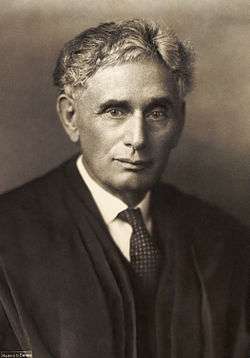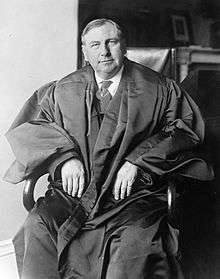The Three Musketeers (Supreme Court)
The "Three Musketeers" was the nickname given to three liberal members during the 1932–37 terms of the United States Supreme Court, who generally supported the New Deal agenda of President Franklin Delano Roosevelt. They were Justices Louis Brandeis, Benjamin N. Cardozo, and Harlan Fiske Stone.[1] They were opposed by the Four Horsemen, consisting of Justices James Clark McReynolds, George Sutherland, Willis Van Devanter, and Pierce Butler. Chief Justice Charles Evans Hughes and Justice Owen J. Roberts controlled the balance.
During the 1935 term, the Four Horsemen would often ride together to and from Court in order to coordinate their positions. To counter them, the Three Musketeers started meeting at Brandeis's apartment on Friday afternoons. However, the Four Horsemen held sway, leading to Roosevelt's court-packing scheme. In 1937, in the "switch in time that saved nine," Roberts and Hughes switched to the liberal side in several key decisions; within a year, Van Devanter and Sutherland retired to be replaced by Hugo Black and Stanley Reed, strong New Dealers. This ended the Four Horsemen's sway. By 1941, Brandeis, Cardozo, Butler, McReynolds, and Hughes were also gone. Only Stone and Roberts remained, and by then Stone had been elevated to the position of Chief Justice.
References
Sources
- White, G. Edward (2000). The Constitution and the New Deal. Cambridge, MA: Harvard University Press. p. 385. ISBN 978-0-674-00831-1.
Notes
- ↑ White, at 81.


